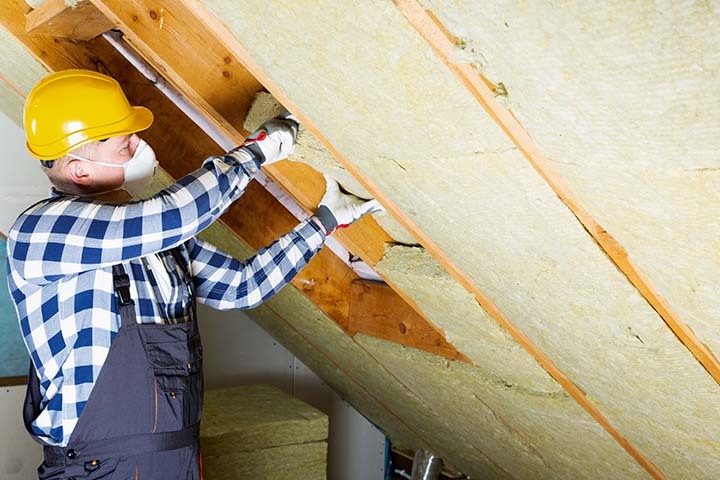Your home benefits greatly from loft insulation as a leading method to boost energy efficiency. This system stops heat from escaping through roofs which maintains your interior temperature.
Having quality loft insulation lets you maintain comfortable temperatures while lowering your utility bill expenses and carbon emissions.
This document explains both the operational mechanics of loft insulation and its defensive value as a smart home investment.
The Physics Behind Loft Insulation
When discussing how loft insulation functions you need to study some fundamental rules of physics. Heat transfers automatically from warmer zones to colder zones.
Homeowners experience warm indoor air passing through roof space and walls and windows throughout winter months. This process is known as heat transfer and occurs in three main ways: conduction, convection, and radiation.
- Conduction: Heat moves through solid materials. When roof tiles lack proper insulation heat escapes through their material.
- Convection: The vacant gaps in your roof let warm interior air rise up and escape.
- Radiation: Heat emits in multiple directions thus it passes up through unsealed attics.
Loft insulation establishes an impermeable barrier to serve as insulation which blocks thermal transfer and saves energy needed to heat your home. This, in turn, results in significant energy savings.
How Loft Insulation Works?
Loft insulation materials create insulation by containing tiny pockets of air that stop heat loss material from happening.
The options for loft insulation materials include fiberglass alongside mineral wool together with sustainable choices based on sheep’s wool and recycled cellulose which exhibit low thermal conductivity characteristics. The materials restrict thermal passage to the outside making heat flow difficult.
The appropriate installation of insulation materials in the loft territories results in dense layers which stop heat from escaping by way of the rooftop.
During warmer months insulation protects your house against outdoor heat while retaining a cool temperature inside.
Thickness Matters
When insulating an attic space the thermal insulation needs to reach an appropriate thickness to accomplish its intended blocking effect.
The goal depth recommended by energy experts for successful results stands at 270 millimeters. The performance of insulation in heat loss reduction varies according to its thickness.
Benefits of Loft Insulation
1. Reduce Heat Loss
The core advantage of loft insulation consists of its power to minimize heat loss from homes. Effective insulation traps heat inside the home so you need your heating system less often which reduces your power usage.
2. Save on Heating Bills
Insulating your loft properly brings substantial savings to your heating bill. Studies show heating your home without insulation can cause heat loss up to 25 percent through roof leakage.
Adding insulation to your home might decrease your heating bills up to 20% based on your property dimensions together with how efficient your home already is.
3. Eco-Friendly Solution
Using insulation in your loft represents a sustainable method to decrease your impact on climate change. The energy you conserve through household usage diminishes both your energy consumption and created greenhouse gas emissions.
People striving to create sustainable homes should consider sheep’s wool or recycled insulation materials when insulating their lofts.
4. Improved Comfort
Loft insulation delivers uniform heating throughout your home by eliminating both chilly areas and draft leaks during winter months.
Loft insulation provides summer heat protection resulting in your home remaining more comfortable through warm and hot seasons.
5. Long-Term Savings
The initial expenses of loft insulation installation will be offset by energy savings that emerge due to insulation installation.
This long-lasting solution extends its functionality for four decades and delivers regular benefits back to the investor.
Loft Insulation Dos and Don'ts
To get the most out of loft insulation, it’s essential to follow some key guidelines. Proper installation and maintenance ensure optimal performance.
Dos:
Do check for existing insulation: If you already have insulation but it’s old or damaged, consider upgrading it to meet current energy standards.
Do seal gaps and cracks: Insulation works best when air leakage is minimized. Seal gaps in the roof and around pipes or vents before installing insulation.
Do choose the right material: Select insulation that suits your budget, environmental goals, and home type.
Don’ts:
Don’t compress the insulation: Insulation relies on trapped air to block heat transfer. Compressing it reduces its effectiveness.
Don’t block ventilation: Proper airflow in the loft prevents moisture buildup, which can lead to mold or rot. Ensure that vents are not obstructed.
Don’t ignore safety precautions: Wear protective clothing when installing insulation, as some materials like fiberglass can irritate the skin and lungs.
Types of Loft Insulation Materials
There are several types of loft insulation materials available, each with unique benefits.
- Fiberglass Insulation: One of the most popular options due to its affordability and effectiveness. It’s made from recycled glass and sand, making it a partially eco-friendly choice.
- Mineral Wool: Another common option, offering excellent fire resistance and soundproofing properties.
- Sheep’s Wool: A sustainable and biodegradable material that’s great for eco-conscious homeowners.
- Spray Foam Insulation: Provides a seamless layer of insulation but can be more expensive than other options.
- Recycled Cellulose: Made from shredded recycled paper, this option is both environmentally friendly and highly effective.
Home Insulation Tips for Energy Savings
Energy efficiency extends beyond loft space management into various other areas of the house. Here are some tips to ensure your entire home is well-insulated:
- Insulate Walls: The amount of heat loss through walls amounts to 35%. Better energy performance emerges when cavity wall insulation joins with loft insulation systems.
- Seal Windows and Doors: Applying draught-proof sealants to window and door openings stops heat from leaving the building.
- Upgrade Glazing: Multiple pane glazings help minimize heat escape while improving energy performance throughout the space.
- Use Insulated Curtains: Thermal curtains function as effective indoor insulation which stops heat from escaping in winter weather conditions.
Loft Insulation Grants and Financial Support
Homeowners who install loft insulation can benefit from government-funded financial benefits. Grants from these programs decrease major installation expenditures thus supplying more economical heating possibilities for all households.
Households in the UK who join the Energy Company Obligation (ECO) program can get their loft insulation free or receive discounted rates through eligible participation.
Ask your local authority together with your energy provider about financial help options that fit your requirements.
Common Myths About Loft Insulation
1. My Home Doesn’t Need Insulation
Modern houses still need better insulation to maximize their energy performance. Building regulations experience regular changes thus newer materials currently outperform traditional versions.
2. Loft Insulation Makes Homes Too Hot in Summer
When installed correctly insulation maintains consistent temperatures throughout the year protecting your home from summer heat while providing needed warmth during winter.
3. It’s Too Expensive
Although insulation for lofts requires an initial investment homeowners can expect long-term financial advantages through this smart ecological investment.
Together with incentives and grants people can reduce expenses linked to the initial installation costs.
Conclusion
Loft insulation represents an easy yet efficient method which decreases heat loss through ceilings and produces both power-saving results and reduced heating expenses.
Your roof space insulated with thermal barriers maintains year-round comfort together with reduced domestic power utilization.
Together with proper material selection and best practice implementation and grant application building owners can achieve the most beneficial results.
Loft insulation stands as an accessible sustainable solution that creates enduring energy efficiency benefits for residential homes. Jumpstart your journey toward a warmer sustainable home because the time to act is now.
Frequently Asked Questions
Loft insulation traps heat by reducing heat transfer through the roof, keeping warm air inside during winter and blocking excessive heat in summer.
It creates a thermal barrier that slows down the movement of heat, preventing warmth from escaping in winter and keeping interiors cooler in summer.
Insulation minimizes heat transfer, reducing the need for heating and cooling, which in turn lowers energy consumption.
By reducing heat loss, loft insulation lowers energy bills by decreasing the need for artificial heating and cooling.








